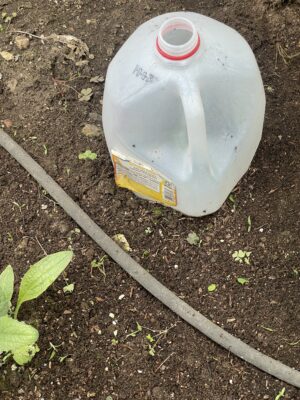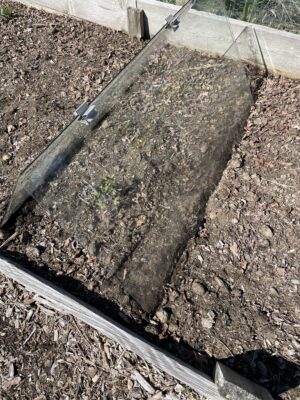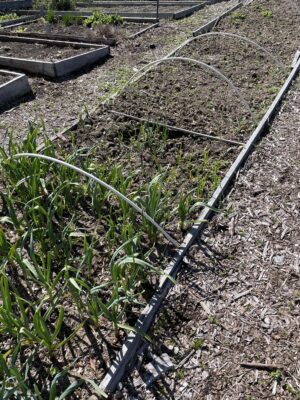Now that it’s spring in New England, it’s time for planting in the garden the vegetables and flowers that I started weeks ago in the greenhouse. But to do this, I have a special concern. Compared with inland temperatures, my garden in spring is significantly cooler due to winds that blow directly across the still cold ocean water I live next to. These cool spring winds are intensified when the city of Providence to my north heats up on sunny days, drawing in wind off the water because of the temperature gradient. This pattern slows the growth of every plant in my garden.

To combat this springtime issue, I use glass cloches to protect young plants from the winds. In America, gardeners often use glass or plastic bell jars as cloches, but these have disadvantages. For one thing, they need to be individually removed to water each plant. For another, the temperature inside them, because of their small size, can overheat quickly in bright sunshine. Instead I use large panes of glass as garden cloches, as is done in England.
Most of my glass panes come from our local transfer station where windows and patio doors are left for disposal or reuse. In making cloches from these panes, my biggest problem has been finding ways to hold two panes together sturdily enough so that they don’t accidentally fall onto the plants. Some 20 years ago, I bought some aluminium clips for this purpose in England but haven’t been able to find similar clips since. The clips I have work extremely well for holding together smaller panes of glass, ones measuring 24 to 30 inches (about 60 to 75 cm). Unfortunately, though, they’re not reliable for supporting larger panes, as some squished young cabbage plants can attest.

One alternative I tried was to make wooden clips from 2×4 inch (50×100 mm) lumber by cutting a deep groove in the wood at a 45-degree angle to the surface. The clips were then slid onto the top of the glass to hold it in place. But an unanticipated problem was that these clips have no flexibility, so higher winds tended to move the glass around, causing it to break. As I said in last month’s story, cleaning up shards of glass from a garden is a miserable chore that takes forever!
I also looked for solutions in different styles of cloche. One of the easiest styles to make is done by bending 5/8-inch (15 mm) plastic water pipes at intervals over my 4 foot (1.3 m) wide raised beds and then covering the pipes with plastic sheeting to form a hoop-shaped enclosure. However, this idea has drawbacks too. Watering the plants can be inconvenient, and the temperature inside the enclosure can reach 90°F (32°C) on sunny spring days, causing the plants to transpire more quickly and wilt. Eventually, I resorted to covering the pipes with plastic sheeting only if overnight frost was forecast.

I’ve now found that the best solution is simply to use panes of glass that are wide enough to cover a raised bed by laying them flat on top of the bed’s wooden edges. The panes can then be slid aside for watering the plants, and gaps at the ends of the panes provide ventilation. Although this is not an ideal solution, it works well enough until the plants start butting up against the glass. At that point, though, it’s usually late enough in spring for the plants to continue growing well without special protection.
If you don’t have easy access to no-cost panes of glass, you can make a portable cloche or a covered growing space using far lighter polycarbonate. You don’t need to build a huge cloche either. Cloches can be built in any size depending on the size of the glazing you have available.


